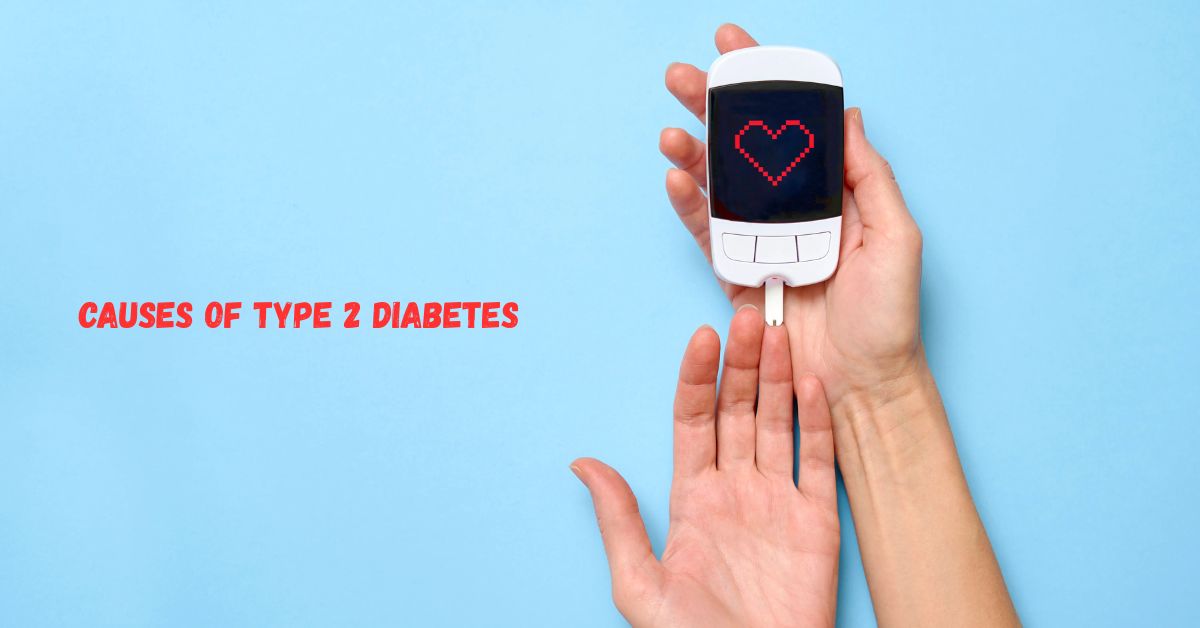Type 2 Diabetes is a chronic, progressive condition that affects how your body uses glucose (sugar) for energy. It occurs when your body becomes resistant to insulin or when the pancreas can no longer produce enough insulin. The result is a steady rise in blood sugar levels, which can damage blood vessels, nerves, and organs over time.
According to the World Health Organization (WHO), Type 2 Diabetes is responsible for the majority of diabetes cases worldwide. While the symptoms and treatments are well-known, the causes of Type 2 Diabetes are more complex and multifaceted. They range from poor diet and inactivity to genetic, hormonal, and even environmental influences.
This guide explores every known cause of Type 2 Diabetes, breaking them down into understandable sections to help you take preventive action.
Core Definition of Type 2 Diabetes and Its Biological Basis
Type 2 Diabetes develops when two key biological processes go wrong:
- Insulin Resistance – the body’s cells stop responding to insulin properly.
- Insulin Deficiency – the pancreas cannot produce enough insulin to overcome resistance.
Insulin is the hormone that allows sugar to move from the bloodstream into the cells. When insulin can’t do its job, sugar builds up in the blood. Over time, high blood sugar causes damage throughout the body, including the eyes, kidneys, heart, and nerves.
This dysfunction doesn’t happen overnight. It is often the result of years of gradual change influenced by lifestyle, genetics, and other hidden factors.
Primary Cause: Insulin Resistance and How It Develops
Insulin resistance is the root problem behind Type 2 Diabetes. It occurs when the muscle, liver, and fat cells don’t respond well to insulin and can’t use glucose for energy. To compensate, the pancreas produces more insulin.
What causes insulin resistance?
- Accumulation of visceral (belly) fat
- High consumption of refined carbohydrates
- Inactivity
- Inflammation in the body
As insulin resistance worsens, the pancreas eventually can’t keep up. That’s when blood sugar begins to rise and Type 2 Diabetes sets in.
Pancreatic Beta Cell Dysfunction in Type 2 Diabetes
Your pancreas contains beta cells that produce insulin. In Type 2 Diabetes, these cells wear out from overwork.
Causes of beta cell damage:
- Chronic high blood sugar (glucotoxicity)
- High levels of fat in the blood (lipotoxicity)
- Inflammation in the pancreas
- Genetic vulnerabilities
Once beta cells begin to fail, insulin production drops further accelerating blood sugar problems.
Obesity as a Driving Factor of Insulin Resistance
Obesity is one of the most significant causes of Type 2 Diabetes. The more excess weight a person carries, particularly around the abdomen, the harder it is for insulin to do its job.
How obesity causes insulin resistance:
- Fat cells release inflammatory chemicals that block insulin
- Fat builds up in the liver and muscles, disrupting glucose metabolism
- Obesity often leads to high blood pressure and high cholesterol, which worsen diabetes risk
Even modest weight loss (5–10%) can significantly improve insulin sensitivity.
Sedentary Lifestyle and Its Role in Metabolic Decline
A lack of regular physical activity reduces the body’s ability to use glucose effectively.
Physical inactivity leads to:
- Increased belly fat
- Lower muscle mass (which uses more glucose)
- Reduced insulin sensitivity
Spending hours sitting every day whether watching TV, driving, or working at a desk contributes to the slow, silent development of Type 2 Diabetes.
Dietary Habits: Refined Carbs, Sugars, and Processed Foods
One of the most controllable causes of Type 2 Diabetes is poor nutrition. Diets high in ultra-processed foods, added sugars, and refined carbohydrates overwhelm the pancreas and raise insulin demand.
Worst offenders:
- White bread and pasta
- Sugary cereals and snacks
- Cakes, cookies, and pastries
- Sweetened drinks
These foods digest quickly, spike blood sugar, and promote insulin resistance.
Impact of Sugar-Sweetened Beverages and Junk Food
Sodas, energy drinks, flavoured coffees, and even “healthy” fruit juices can contain massive amounts of sugar.
Why they’re dangerous:
- Provide high calories without nutrients
- Cause rapid blood sugar and insulin spikes
- Promote fat gain and inflammation
- Contribute to fatty liver disease
Frequent consumption of sugary drinks is directly linked to the early onset of Type 2 Diabetes.
Genetic Predisposition and Family Medical History
If you have a parent, sibling, or grandparent with Type 2 Diabetes, your risk increases significantly.
What’s inherited:
- Insulin resistance genes
- Genes affecting how your pancreas works
- Genes that impact body fat distribution
Genetics set the stage, but lifestyle pulls the trigger. Even those with strong family history can delay or prevent diabetes with the right actions.
Ethnicity, Cultural Factors, and Diabetes Risk

Some ethnic groups are more likely to develop Type 2 Diabetes due to genetic and cultural factors.
High-risk populations include:
- South Asians
- African Americans
- Native Americans
- Pacific Islanders
- Hispanics
Traditional diets, limited access to healthy foods, and inherited metabolic traits contribute to the higher risk in these groups.
Age-Related Decline in Insulin Sensitivity and Metabolism
The risk of developing Type 2 Diabetes increases with age. This is due to:
- Loss of muscle mass (sarcopenia)
- Weight gain, especially around the belly
- Decreased physical activity
- Declining beta cell function
After age 45, regular screenings are recommended, especially for those with other risk factors.
Hormonal Imbalances: Cortisol, Estrogen, and Thyroid Influence
Hormones significantly influence blood sugar levels and insulin action.
Imbalances that contribute:
- Cortisol: Chronic stress raises cortisol, increasing insulin resistance.
- Estrogen: Drops after menopause worsen glucose metabolism in women.
- Thyroid disorders: Both hyper- and hypothyroidism affect insulin use.
Managing hormonal health is an important part of preventing diabetes.
Sleep Disorders, Stress, and Their Link to Diabetes
Chronic stress and poor-quality sleep increase diabetes risk by disrupting hormones and promoting inflammation.
Negative effects:
- Increased appetite for sugary foods
- Elevated blood sugar levels
- Impaired insulin response
- Reduced energy for exercise
Improving sleep hygiene and stress management can greatly reduce risk.
PCOS and Its Contribution to Female Insulin Resistance
Polycystic Ovary Syndrome (PCOS) is a hormonal disorder common among women of reproductive age and is closely linked with Type 2 Diabetes.
How PCOS contributes:
- Causes elevated levels of insulin
- Promotes fat storage and weight gain
- Worsens insulin resistance
- Leads to irregular menstruation and fertility issues
Women with PCOS have up to a 4–5x higher risk of developing Type 2 Diabetes, especially if overweight or sedentary.
Gestational Diabetes as a Precursor to Type 2 Diabetes
Gestational Diabetes occurs during pregnancy and usually resolves after childbirth. However, it significantly increases the risk of future Type 2 Diabetes for both the mother and the child.
Risk trajectory:
- Women with gestational diabetes are up to 60% more likely to develop Type 2 Diabetes within 10 years.
- Babies born to mothers with gestational diabetes are more likely to become overweight and insulin resistant later in life.
Post-pregnancy monitoring and lifestyle changes are crucial.
Understanding Prediabetes and Metabolic Syndrome
Prediabetes is a warning sign. Blood sugar levels are higher than normal but not yet high enough to be classified as diabetes.
Indicators of prediabetes:
- Fasting blood glucose of 100–125 mg/dL
- HbA1c of 5.7–6.4%
- Insulin resistance without full symptoms
Often accompanying this is metabolic syndrome, a cluster of risk factors:
- High waist circumference
- Elevated triglycerides
- Low HDL cholesterol
- High blood pressure
- High fasting glucose
Addressing these early can stop the transition to Type 2 Diabetes.
High Blood Pressure, High Cholesterol, and Their Synergy
Hypertension and dyslipidaemia are closely associated with Type 2 Diabetes. These conditions share common causes and often occur together.
Interactions:
- High blood pressure increases insulin resistance.
- High LDL and triglycerides damage blood vessels and hinder insulin delivery.
- Low HDL (good cholesterol) is common in diabetics.
This dangerous combination increases the risk of heart attacks, strokes, and kidney failure in diabetics.
Inflammation and Oxidative Stress in Insulin Disruption
Chronic low-grade inflammation interferes with insulin’s ability to bind to cells. This is often seen in people with obesity, metabolic syndrome, and fatty liver disease.
What triggers inflammation?
- Poor diet (trans fats, processed meats)
- Excess visceral fat
- Gut imbalances
- Environmental toxins
Antioxidant-rich foods, anti-inflammatory diets, and exercise help counter these effects.
Environmental and Chemical Triggers (e.g., BPA, Pesticides)
Endocrine-disrupting chemicals (EDCs) in plastics, cosmetics, and pesticides may affect insulin sensitivity and beta cell function.
Common EDCs:
- BPA: Found in plastic bottles, food cans
- Phthalates: Found in personal care products
- Pesticides: Found in non-organic produce
Though more research is needed, reducing exposure to these chemicals may help lower the risk of Type 2 Diabetes.
Pharmaceuticals: Steroids, Antipsychotics, and Statins

Some medications unintentionally contribute to Type 2 Diabetes development.
Examples:
- Corticosteroids (for inflammation): Raise blood sugar
- Atypical antipsychotics: Increase weight and insulin resistance
- Statins: May impair insulin sensitivity in some individuals
Patients taking these medications should be monitored regularly for glucose changes.
Alcohol, Nicotine, and Recreational Drug Impact
Substance abuse has a direct impact on insulin function and liver health.
Smoking:
- Increases abdominal fat
- Raises cortisol levels
- Promotes inflammation
Alcohol:
- Leads to weight gain and fatty liver
- Spikes blood sugar when mixed with sugary drinks
Avoiding these substances not only lowers diabetes risk but improves overall metabolic health.
The Microbiome: Gut Health and Glucose Metabolism
The trillions of microbes in your gut play a critical role in immune function, hormone production, and metabolism.
Poor gut health can lead to:
- Inflammation
- Leaky gut syndrome
- Disrupted insulin signalling
Consuming probiotics, prebiotics, and fibre helps maintain a healthy microbiome and reduces the risk of Type 2 Diabetes.
Socioeconomic Status, Education, and Access to Healthy Living
People in lower-income communities often face barriers that contribute to Type 2 Diabetes.
Challenges include:
- Limited access to fresh produce
- Unsafe environments for exercise
- Lack of healthcare education
- Greater exposure to fast food marketing
These social determinants must be addressed in public health strategies to reduce disease prevalence.
Childhood Obesity and Long-Term Diabetes Risk
Obese children are more likely to carry excess weight into adulthood, setting the stage for early-onset Type 2 Diabetes.
Causes of childhood obesity:
- High-sugar diets
- Lack of physical activity
- Screen time over outdoor play
- Sugary drinks marketed to kids
Healthy lifestyle habits must be taught early to prevent future health crises.
Global Urbanisation, Fast Food Culture, and Disease Burden
Urbanisation is associated with lifestyle shifts that increase diabetes risk.
Urban health risks:
- Greater fast food consumption
- Sedentary desk jobs
- Less sleep and higher stress
- More pollution and toxin exposure
Countries adopting Western diets and lifestyles are seeing a sharp rise in Type 2 Diabetes.
Sex-Specific Risk Profiles: Male vs Female Diabetes Causes
Gender affects how diabetes develops and progresses.
Men:
- More visceral fat
- Greater risk of heart disease
- Often delay diagnosis
Women:
- Hormonal changes (PCOS, menopause)
- Higher stress-related eating
- More likely to develop diabetes post-pregnancy
Understanding these differences enables more targeted prevention and care.
Barriers to Screening, Awareness, and Early Detection
Many people with prediabetes or early Type 2 Diabetes are unaware of their condition.
Why diagnosis is delayed:
- No symptoms in early stages
- Lack of routine checkups
- Cultural stigma
- Inadequate public health messaging
Early diagnosis is critical because lifestyle changes are most effective in the prediabetic stage.
Interconnected Web of Causal Factors and Feedback Loops
The causes of Type 2 Diabetes do not exist in isolation. They form a complex, interrelated web.
Example:
- Poor diet → weight gain → insulin resistance → high blood sugar → beta cell failure
- Stress → poor sleep → cortisol spike → sugar cravings → overeating
This cycle continues unless interrupted through intentional lifestyle interventions.
Lifestyle-Based Prevention Strategies from Causal Analysis
The best way to prevent Type 2 Diabetes is by targeting its causes directly.
Effective strategies:
- Eat a low-glycaemic, whole-food diet
- Exercise 30 minutes daily
- Get 7–9 hours of sleep
- Avoid sugary drinks and ultra-processed food
- Reduce stress through mindfulness, hobbies, and support
These actions work together to improve insulin sensitivity, preserve pancreatic function, and maintain a healthy metabolism.
FAQs:
1. What are the main causes of Type 2 Diabetes?
The main causes of Type 2 Diabetes include insulin resistance, obesity, poor diet, lack of physical activity, genetic predisposition, and hormonal imbalances. These factors gradually impair the body’s ability to regulate blood sugar.
2. Can stress cause Type 2 Diabetes?
Yes, chronic stress can lead to elevated cortisol levels, which interfere with insulin function, increase blood sugar, and promote unhealthy eating habits. Over time, this may contribute to the development of Type 2 Diabetes.
3. Does eating sugar directly cause Type 2 Diabetes?
Not directly. However, a diet high in added sugars and refined carbs can lead to weight gain and insulin resistance two major risk factors for developing Type 2 Diabetes.
4. How does genetics influence Type 2 Diabetes risk?
Genetics can increase your likelihood of developing insulin resistance or having a weaker pancreatic response. If you have a family history, your risk is significantly higher, but lifestyle still plays a major role.
5. Can medications cause Type 2 Diabetes?
Yes, some medications such as corticosteroids, antipsychotics, and certain cholesterol-lowering drugs can impair glucose metabolism or promote weight gain, increasing the risk of Type 2 Diabetes.
6. Is Type 2 Diabetes preventable if causes are addressed early?
In many cases, yes. Addressing modifiable causes such as diet, exercise, and weight can delay or even prevent the onset of Type 2 Diabetes, especially in individuals with prediabetes or high risk.
Must Read:
- What Is Type 2 Diabetes Definition?
- 4 Digestive Issues You Shouldn’t Ignore
- 10 Causes of Sudden Weight Gain
Conclusion:
Type 2 Diabetes is not caused by one single factor but by a collection of interdependent influences genetic, lifestyle-related, hormonal, and environmental. By understanding these root causes in depth, we empower ourselves and our communities to take real action toward prevention.
With proper education, support systems, and access to healthy choices, millions of people can delay or avoid a diagnosis altogether. Knowledge truly is the first step toward prevention, and prevention is the best cure.
